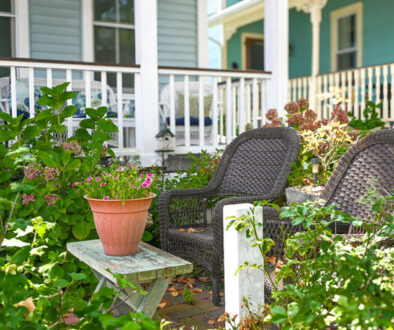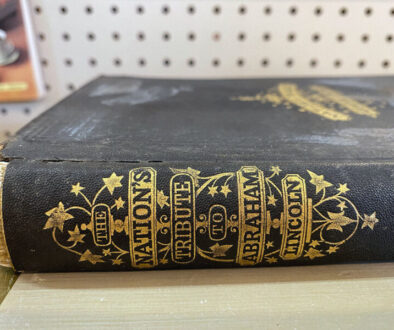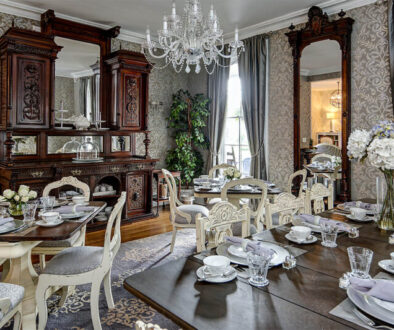The Grass is Always Greener

Did you know that lawn is the largest crop in America? It is estimated that turf grass covers approximately 1.6% of the surface area of the entire country—more than 62,500 square miles. That is an area larger than Pennsylvania, New Jersey, and Connecticut combined!
What’s disturbing is that we spend an estimated $62 billion dollars a year to maintain this crop, and we can’t even eat it. In fact we discard what we harvest. Lawns also require an inordinate amount of water, gasoline, chemicals and time—three trillion gallons of water, 1.2 billion gallons of gas for our lawn mowers (plus another 17 million gallons that are spilled while filling the machines), and 90 million pounds of pesticides and herbicides, according to the U.S. Department of Energy and the EPA. Running a lawn mower for one hour can generate the same amount of pollution as driving a new car 45 miles. And let’s not forget the lawn trimmers.
One more thing: turf grasses are not native plants, not even Kentucky bluegrass. So, they provide very little in the way of food or shelter to wildlife.
History of Lawn
But it wasn’t always this way. The concept of a residential lawn is relatively new. Great lawns started out as a practical way to protect manor houses from surprise attacks in 18th-century England and France. They soon became symbols of wealth and status. Remember, the environmental concerns we have today didn’t exist yet, and wealthy landowners had the resources to maintain those lawns. Scores of servants and enslaved people toiled with sickles, aided by sheep and other grazing animals, to keep the turf in tip-top shape.
The concept of lawn was brought to this country by people like George Washington and Thomas Jefferson. It was further propelled by Frederick Law Olmstead in his designs of Central Park and the first planned communities. His vision was to create “green spaces that were accessible and enjoyed by all, not just the wealthy.”

In 1870, Frank J. Scott wrote an impactful book called The Art of Beautifying Suburban Home Grounds, in which he talked about the social importance of having a lawn. “With our open-faced front lawns we declare our like-mindedness to our neighbors, and our distance from the English, who surround their yards with inhospitable brick walls.” Coincidentally, 1870 was also the year the lawn mower was invented.
Fast forward to 1944, when the GI bill made home ownership affordable for so many average Americans. Soon lawns began popping up everywhere.
Why Lawn?
There are naturalists today who are advocating the abolition of lawns altogether in favor of meadow grasses. Even Finegardening.com is encouraging people to stop “yardening” and start gardening. But there is no need to eliminate all your lawn. New and somewhat radical ideas are often taken to an extreme and therefore met with resistance. The answer often lies somewhere in the middle. Combine a little of the old with a little of the new, add a dash of practicality and common sense, and voila!
There are many practical reasons for including some lawn in your landscape. Children need a place to play, dogs need it too, and nothing feels quite like walking barefoot in soft, cool grass. It can also be a good alternative to hardscaping when coverage issues are a concern. Grass is certainly better than concrete! It can be used as a walkway or even around a pool—although maintenance around water can be tricky.

But how much lawn do you really need? The mistake that most people make when designing their own landscapes is that they start by designing the shapes of their garden beds and what space is left over becomes lawn. The result is usually too much lawn and planting beds with wavy borders and no actual shape. Professionals are taught to do exactly the opposite: design the negative space (i.e. lawn) first and what’s left becomes planting beds.
Think about incorporating other ground cover plants in places where you would have formerly and automatically put grass, like areas where you have steppingstones or simply don’t walk much. Creeping thyme, sweet woodruff, creeping Jenny, clover, or moss (if it’s shady) can be good substitutes. In areas where you don’t walk at all, try carex, liriope, golden carpet sedum, or other low growing perennials.
Artificial turf is also an option, although I am not a fan. In my opinion, the only place it belongs is on miniature golf courses and maybe athletic fields. FYI, Cape May banned its residential use last spring.
Growing Grass
Why is the grass always greener on the other side of the fence? The truth is it probably isn’t. As in life, it’s a matter of perspective, literally. You view the grass under your feet at a 90-degree angle. As you look straight down on it, you can easily see any bare spots and distinguish between grass and weeds. However, you view your neighbor’s lawn at somewhere between a 30- to 45-degree angle and from a greater distance. What you see behind each blade of grass is more grass—bare spots aren’t apparent, and you can’t tell the difference between crabgrass, clover, and real turf—it all looks green! I bet you feel better about your lawn already.
Growing a beautiful lawn can seem like a daunting task at first. But if you understand a few basics about what you are trying to grow and/or get rid of (i.e. weeds), it’s not as hard as you might think.

First, understand your environment. Cape May has sandy soil that doesn’t hold water or nutrients well. Generally, it should be amended when planting a new lawn. You will need to fertilize regularly and most likely provide some kind of supplemental water. Humidity is frequently high here, and we often have excessive dew, two factors that promote lawn disease. Our summer sun is hot, and the wind is ever present no matter what time of year it is, resulting in evaporation.
Secondly, evaluate your property and your needs. How much shade do you have? Will there be an irrigation system? How much wear and tear will your lawn have to withstand: regular foot traffic, children playing, dogs, and if so—how big are they? What kind of soil do you have? Once you know the answers to these questions, you can choose the right type of turf for your landscape.
There are many types of grass, but here in Cape May you really only need to know three: Kentucky bluegrass, perennial rye, and tall fescue.
Kentucky bluegrass (KBG) is what most people think of when they envision the perfect lawn. This popular grass is deep emerald, blue green, finely textured, soft, dense, and lush. But it is high maintenance. It’s a slow grower that doesn’t like deep shade, and due to its relatively shallow roots, almost always requires supplemental water and more fertilizer than other types of grass. On the plus side, it can heal quickly from damage due to its extensive system of rhizomes and has excellent winter hardiness.
Perennial rye is dark green, shiny and soft. It is the quickest germinating lawn seed (about one third of the time of KBG) and therefore is often combined with KBG in seed mixes. It’s a low maintenance, pest resistant grass that is tolerant of foot traffic but not extreme cold or drought.
Tall Fescue is dark green and coarser than the first two and is probably the best grass suited for our environment. Because of its deep root system, it can tolerate heat and drought better than other cool season grasses and therefore requires less supplemental watering. It can grow in full sun or light shade, tolerates foot traffic well, and most importantly, is disease resistant.
Starting from Scratch: Sod vs Seed
Sod is more expensive to buy and install but will give you instant results. It can be installed anytime during the growing season, roots in two to three weeks, and requires fewer weed prevention chemicals. You also get immediate erosion control, which is especially important if you are trying to grow grass on a slope. And no mud will be continually tracked inside your house by workmen, children, and pets! The only downside is cost and the type of sod that is available which may not be ideal for your soil type or light requirements. Shade can be especially challenging, as most sod is grown in full sun.
The number one reason for choosing seed over sod is cost. Depending on your site’s condition, the type and brand of seed you choose and whether you DIY it, the cost of seed can be as much as one tenth that of sod. However, seeding requires time, patience, more maintenance to get it started, and more water. Seed takes about two to four weeks to germinate depending on the variety, another three to four weeks before you can mow it, and up to a year before it’s totally established. During all that time it’s subject to wash out and weed invasion. Your yard may also need to be seeded more than once.



Having said all that, seeding can still result in a beautiful lawn. So, what seed is best? The one that is right for your property’s conditions, which is almost always a mix. Please note not all seed is created equal. Good quality seed has a coating that helps it absorb more water, provides nutrients, and protects it from disease. Look for one that has TWCA (Turfgrass Water Conservation Alliance) qualification and the least amount of weed seed. Well-known brands like Scotts, Pennington, or Jonathan Green are worth it. One of the best seed mixes for this area was developed by our own Church’s Garden Center over 40 years ago. It is largely tall fescue but also contains a little KBG and perennial rye—and no weed seed. Whatever you decide, don’t cheap out. You will likely be disappointed with the results if you do.
The optimal time to seed a new lawn is late August to September when temps are between 60 and 75 degrees, but not later than 45 days before the first fall frost. First, clear away any debris. Test your soil and amend it if necessary. Rake the soil to loosen and level it. Apply a starter fertilizer, one that has no weed preventative or killer and a high level of phosphorus, which will promote root growth. Spread the seed and lightly rake it in. Water regularly. Don’t let the seed dry out. Nature will take care of the rest.
Please look for The Grass is Always Greener, Part Two next spring, when we will cover how to care for your beautiful lawn. In the meantime,
‘’Let your lawn be your home’s velvet robe, and your flowers its not too promiscuous decoration.’’
– Frank J. Scott



